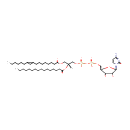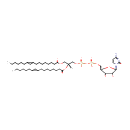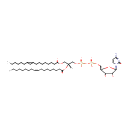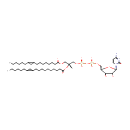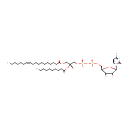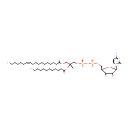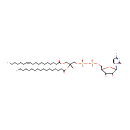
Search Results for compounds
Searching compounds for
returned 4373 results.
Displaying compounds 2791 - 2800 of
4373 in total
CDP-DG(17:0cycw7c/15:0cyclo) (PAMDB006818)
IUPAC:
{[(2R,3R,5R)-5-(4-amino-2-oxo-1,2-dihydropyrimidin-1-yl)-3,4-dihydroxyoxolan-2-yl]methoxy}({[(2R)-2-{[8-(2-butylcyclopropyl)octanoyl]oxy}-3-{[8-(2-hexylcyclopropyl)octanoyl]oxy}propoxy](hydroxy)phosphoryl}oxy)phosphinic acid
CAS: Not Available
Description: CDP-DG(17:0cycw7c/15:0cyclo) belongs to the family of CDP-diacylglycerols. It is a glycerophospholipid containing a diacylglycerol, with a cytidine diphosphate attached to the oxygen O1 or O2 of the glycerol part. As is the case with diacylglycerols, phosphatidylserines can have many different combinations of fatty acids of varying lengths and saturation attached to the C-1 and C-2 atoms. CDP-DG(17:0cycw7c/15:0cyclo), in particular, consists of one heptadec-9-10-cyclo-anoyl chain to C-1 atom, and one cis-9,10-Methylenetetradecanoic acid to the C-2 atom. In Pseudomonas aeruginosa glycerophospholipid metabolism, The biosynthesis of CDP-diacylglycerol (CDP-DG) involves condensation of phosphatidic acid (PA) and cytidine triphosphate, with elimination of pyrophosphate, catalysed by the enzyme CDP-diacylglycerol synthase. The resulting CDP-diacylglycerol can be utilized immediately for the synthesis of phosphatidylglycerol (PG), and thence cardiolipin (CL), and of phosphatidylinositol (PI). CDP-DG(17:0cycw7c/15:0cyclo) is also a substrate of CDP-diacylglycerol pyrophosphatase. It is involved in CDP-diacylglycerol degradation pathway.
CDP-DG(17:0cycw7c/16:0) (PAMDB006819)
IUPAC:
{[(2R,3R,5R)-5-(4-amino-2-oxo-1,2-dihydropyrimidin-1-yl)-3,4-dihydroxyoxolan-2-yl]methoxy}({[(2R)-2-(hexadecanoyloxy)-3-{[8-(2-hexylcyclopropyl)octanoyl]oxy}propoxy](hydroxy)phosphoryl}oxy)phosphinic acid
CAS: Not Available
Description: CDP-DG(17:0cycw7c/16:0) belongs to the family of CDP-diacylglycerols. It is a glycerophospholipid containing a diacylglycerol, with a cytidine diphosphate attached to the oxygen O1 or O2 of the glycerol part. As is the case with diacylglycerols, phosphatidylserines can have many different combinations of fatty acids of varying lengths and saturation attached to the C-1 and C-2 atoms. CDP-DG(17:0cycw7c/16:0), in particular, consists of one heptadec-9-10-cyclo-anoyl chain to C-1 atom, and one hexadecanoyl to the C-2 atom. In Pseudomonas aeruginosa glycerophospholipid metabolism, The biosynthesis of CDP-diacylglycerol (CDP-DG) involves condensation of phosphatidic acid (PA) and cytidine triphosphate, with elimination of pyrophosphate, catalysed by the enzyme CDP-diacylglycerol synthase. The resulting CDP-diacylglycerol can be utilized immediately for the synthesis of phosphatidylglycerol (PG), and thence cardiolipin (CL), and of phosphatidylinositol (PI). CDP-DG(17:0cycw7c/16:0) is also a substrate of CDP-diacylglycerol pyrophosphatase. It is involved in CDP-diacylglycerol degradation pathway.
CDP-DG(17:0cycw7c/16:1(9Z)) (PAMDB006820)
IUPAC:
{[(2R,3R,5R)-5-(4-amino-2-oxo-1,2-dihydropyrimidin-1-yl)-3,4-dihydroxyoxolan-2-yl]methoxy}({[(2R)-2-[(9Z)-hexadec-9-enoyloxy]-3-{[8-(2-hexylcyclopropyl)octanoyl]oxy}propoxy](hydroxy)phosphoryl}oxy)phosphinic acid
CAS: Not Available
Description: CDP-DG(17:0cycw7c/16:1(9Z)) belongs to the family of CDP-diacylglycerols. It is a glycerophospholipid containing a diacylglycerol, with a cytidine diphosphate attached to the oxygen O1 or O2 of the glycerol part. As is the case with diacylglycerols, phosphatidylserines can have many different combinations of fatty acids of varying lengths and saturation attached to the C-1 and C-2 atoms. CDP-DG(17:0cycw7c/16:1(9Z)), in particular, consists of one heptadec-9-10-cyclo-anoyl chain to C-1 atom, and one 9Z-hexadecenoyl to the C-2 atom. In Pseudomonas aeruginosa glycerophospholipid metabolism, The biosynthesis of CDP-diacylglycerol (CDP-DG) involves condensation of phosphatidic acid (PA) and cytidine triphosphate, with elimination of pyrophosphate, catalysed by the enzyme CDP-diacylglycerol synthase. The resulting CDP-diacylglycerol can be utilized immediately for the synthesis of phosphatidylglycerol (PG), and thence cardiolipin (CL), and of phosphatidylinositol (PI). CDP-DG(17:0cycw7c/16:1(9Z)) is also a substrate of CDP-diacylglycerol pyrophosphatase. It is involved in CDP-diacylglycerol degradation pathway.
CDP-DG(17:0cycw7c/17:0cycw7c) (PAMDB006821)
IUPAC:
{[(2R,3R,5R)-5-(4-amino-2-oxo-1,2-dihydropyrimidin-1-yl)-3,4-dihydroxyoxolan-2-yl]methoxy}({[(2R)-2,3-bis({[8-(2-hexylcyclopropyl)octanoyl]oxy})propoxy](hydroxy)phosphoryl}oxy)phosphinic acid
CAS: Not Available
Description: CDP-DG(17:0cycw7c/17:0cycw7c) belongs to the family of CDP-diacylglycerols. It is a glycerophospholipid containing a diacylglycerol, with a cytidine diphosphate attached to the oxygen O1 or O2 of the glycerol part. As is the case with diacylglycerols, phosphatidylserines can have many different combinations of fatty acids of varying lengths and saturation attached to the C-1 and C-2 positions. CDP-DG(17:0cycw7c/17:0cycw7c), in particular, consists of two heptadec-9-10-cyclo-anoyl chain at positions C-1 and C2. In Pseudomonas aeruginosa glycerophospholipid metabolism, The biosynthesis of CDP-diacylglycerol (CDP-DG) involves condensation of phosphatidic acid (PA) and cytidine triphosphate, with elimination of pyrophosphate, catalysed by the enzyme CDP-diacylglycerol synthase. The resulting CDP-diacylglycerol can be utilized immediately for the synthesis of phosphatidylglycerol (PG), and thence cardiolipin (CL), and of phosphatidylinositol (PI). CDP-DG(17:0cycw7c/17:0cycw7c) is also a substrate of CDP-diacylglycerol pyrophosphatase. It is involved in CDP-diacylglycerol degradation pathway.
CDP-DG(17:0cycw7c/18:1(9Z)) (PAMDB006822)
IUPAC:
{[(2R,3R,5R)-5-(4-amino-2-oxo-1,2-dihydropyrimidin-1-yl)-3,4-dihydroxyoxolan-2-yl]methoxy}({[(2R)-3-{[8-(2-hexylcyclopropyl)octanoyl]oxy}-2-[(9Z)-octadec-9-enoyloxy]propoxy](hydroxy)phosphoryl}oxy)phosphinic acid
CAS: Not Available
Description: CDP-DG(17:0cycw7c/18:1(9Z)) belongs to the family of CDP-diacylglycerols. It is a glycerophospholipid containing a diacylglycerol, with a cytidine diphosphate attached to the oxygen O1 or O2 of the glycerol part. As is the case with diacylglycerols, phosphatidylserines can have many different combinations of fatty acids of varying lengths and saturation attached to the C-1 and C-2 atoms. CDP-DG(17:0cycw7c/18:1(9Z)), in particular, consists of one heptadec-9-10-cyclo-anoyl chain to C-1 atom, and one 9Z-octadecenoyl to the C-2 atom. In Pseudomonas aeruginosa glycerophospholipid metabolism, The biosynthesis of CDP-diacylglycerol (CDP-DG) involves condensation of phosphatidic acid (PA) and cytidine triphosphate, with elimination of pyrophosphate, catalysed by the enzyme CDP-diacylglycerol synthase. The resulting CDP-diacylglycerol can be utilized immediately for the synthesis of phosphatidylglycerol (PG), and thence cardiolipin (CL), and of phosphatidylinositol (PI). CDP-DG(17:0cycw7c/18:1(9Z)) is also a substrate of CDP-diacylglycerol pyrophosphatase. It is involved in CDP-diacylglycerol degradation pathway.
CDP-DG(17:0cycw7c/19:0cycv8c) (PAMDB006823)
IUPAC:
{[(2R,3R,5R)-5-(4-amino-2-oxo-1,2-dihydropyrimidin-1-yl)-3,4-dihydroxyoxolan-2-yl]methoxy}({[(2R)-2-{[10-(2-hexylcyclopropyl)decanoyl]oxy}-3-{[8-(2-hexylcyclopropyl)octanoyl]oxy}propoxy](hydroxy)phosphoryl}oxy)phosphinic acid
CAS: Not Available
Description: CDP-DG(17:0cycw7c/19:0cycv8c) belongs to the family of CDP-diacylglycerols. It is a glycerophospholipid containing a diacylglycerol, with a cytidine diphosphate attached to the oxygen O1 or O2 of the glycerol part. As is the case with diacylglycerols, phosphatidylserines can have many different combinations of fatty acids of varying lengths and saturation attached to the C-1 and C-2 atoms. CDP-DG(17:0cycw7c/19:0cycv8c), in particular, consists of one heptadec-9-10-cyclo-anoyl chain to C-1 atom, and one heptadec-11-12-cyclo-anoyl to the C-2 atom. In Pseudomonas aeruginosa glycerophospholipid metabolism, The biosynthesis of CDP-diacylglycerol (CDP-DG) involves condensation of phosphatidic acid (PA) and cytidine triphosphate, with elimination of pyrophosphate, catalysed by the enzyme CDP-diacylglycerol synthase. The resulting CDP-diacylglycerol can be utilized immediately for the synthesis of phosphatidylglycerol (PG), and thence cardiolipin (CL), and of phosphatidylinositol (PI). CDP-DG(17:0cycw7c/19:0cycv8c) is also a substrate of CDP-diacylglycerol pyrophosphatase. It is involved in CDP-diacylglycerol degradation pathway.
CDP-DG(17:0cycw7c/19:iso) (PAMDB006824)
IUPAC:
Not Available
CAS: Not Available
Description: CDP-DG(17:0cycw7c/19:iso) belongs to the family of CDP-diacylglycerols. It is a glycerophospholipid containing a diacylglycerol, with a cytidine diphosphate attached to the oxygen O1 or O2 of the glycerol part. As is the case with diacylglycerols, phosphatidylserines can have many different combinations of fatty acids of varying lengths and saturation attached to the C-1 and C-2 atoms. CDP-DG(17:0cycw7c/19:iso), in particular, consists of one heptadec-9-10-cyclo-anoyl chain to C-1 atom, and one 17-methylocatdecanoyl to the C-2 atom. In Pseudomonas aeruginosa glycerophospholipid metabolism, The biosynthesis of CDP-diacylglycerol (CDP-DG) involves condensation of phosphatidic acid (PA) and cytidine triphosphate, with elimination of pyrophosphate, catalysed by the enzyme CDP-diacylglycerol synthase. The resulting CDP-diacylglycerol can be utilized immediately for the synthesis of phosphatidylglycerol (PG), and thence cardiolipin (CL), and of phosphatidylinositol (PI). CDP-DG(17:0cycw7c/19:iso) is also a substrate of CDP-diacylglycerol pyrophosphatase. It is involved in CDP-diacylglycerol degradation pathway.
CDP-DG(18:1(11Z)/10:0) (PAMDB006825)
IUPAC:
{[(2R,3R,5R)-5-(4-amino-2-oxo-1,2-dihydropyrimidin-1-yl)-3,4-dihydroxyoxolan-2-yl]methoxy}({[(2R)-2-(decanoyloxy)-3-[(11Z)-octadec-11-enoyloxy]propoxy](hydroxy)phosphoryl}oxy)phosphinic acid
CAS: Not Available
Description: CDP-DG(18:1(11Z)/10:0) belongs to the family of CDP-diacylglycerols. It is a glycerophospholipid containing a diacylglycerol, with a cytidine diphosphate attached to the oxygen O1 or O2 of the glycerol part. As is the case with diacylglycerols, phosphatidylserines can have many different combinations of fatty acids of varying lengths and saturation attached to the C-1 and C-2 atoms. CDP-DG(18:1(11Z)/10:0), in particular, consists of one 11Z-octadecenoyl chain to C-1 atom, and one decanoyl to the C-2 atom. In Pseudomonas aeruginosa glycerophospholipid metabolism, The biosynthesis of CDP-diacylglycerol (CDP-DG) involves condensation of phosphatidic acid (PA) and cytidine triphosphate, with elimination of pyrophosphate, catalysed by the enzyme CDP-diacylglycerol synthase. The resulting CDP-diacylglycerol can be utilized immediately for the synthesis of phosphatidylglycerol (PG), and thence cardiolipin (CL), and of phosphatidylinositol (PI). CDP-DG(18:1(11Z)/10:0) is also a substrate of CDP-diacylglycerol pyrophosphatase. It is involved in CDP-diacylglycerol degradation pathway.
CDP-DG(18:1(11Z)/12:0) (PAMDB006826)
IUPAC:
{[(2R,3R,5R)-5-(4-amino-2-oxo-1,2-dihydropyrimidin-1-yl)-3,4-dihydroxyoxolan-2-yl]methoxy}({[(2R)-2-(dodecanoyloxy)-3-[(11Z)-octadec-11-enoyloxy]propoxy](hydroxy)phosphoryl}oxy)phosphinic acid
CAS: Not Available
Description: CDP-DG(18:1(11Z)/12:0) belongs to the family of CDP-diacylglycerols. It is a glycerophospholipid containing a diacylglycerol, with a cytidine diphosphate attached to the oxygen O1 or O2 of the glycerol part. As is the case with diacylglycerols, phosphatidylserines can have many different combinations of fatty acids of varying lengths and saturation attached to the C-1 and C-2 atoms. CDP-DG(18:1(11Z)/12:0), in particular, consists of one 11Z-octadecenoyl chain to C-1 atom, and one dodecanoyl to the C-2 atom. In Pseudomonas aeruginosa glycerophospholipid metabolism, The biosynthesis of CDP-diacylglycerol (CDP-DG) involves condensation of phosphatidic acid (PA) and cytidine triphosphate, with elimination of pyrophosphate, catalysed by the enzyme CDP-diacylglycerol synthase. The resulting CDP-diacylglycerol can be utilized immediately for the synthesis of phosphatidylglycerol (PG), and thence cardiolipin (CL), and of phosphatidylinositol (PI). CDP-DG(18:1(11Z)/12:0) is also a substrate of CDP-diacylglycerol pyrophosphatase. It is involved in CDP-diacylglycerol degradation pathway.
CDP-DG(18:1(11Z)/17:0) (PAMDB006827)
IUPAC:
{[(2R,3R,5R)-5-(4-amino-2-oxo-1,2-dihydropyrimidin-1-yl)-3,4-dihydroxyoxolan-2-yl]methoxy}({[(2R)-2-(heptadecanoyloxy)-3-[(11Z)-octadec-11-enoyloxy]propoxy](hydroxy)phosphoryl}oxy)phosphinic acid
CAS: Not Available
Description: CDP-DG(18:1(11Z)/17:0) belongs to the family of CDP-diacylglycerols. It is a glycerophospholipid containing a diacylglycerol, with a cytidine diphosphate attached to the oxygen O1 or O2 of the glycerol part. As is the case with diacylglycerols, phosphatidylserines can have many different combinations of fatty acids of varying lengths and saturation attached to the C-1 and C-2 atoms. CDP-DG(18:1(11Z)/17:0), in particular, consists of one 11Z-octadecenoyl chain to C-1 atom, and one heptadecanoyl to the C-2 atom. In Pseudomonas aeruginosa glycerophospholipid metabolism, The biosynthesis of CDP-diacylglycerol (CDP-DG) involves condensation of phosphatidic acid (PA) and cytidine triphosphate, with elimination of pyrophosphate, catalysed by the enzyme CDP-diacylglycerol synthase. The resulting CDP-diacylglycerol can be utilized immediately for the synthesis of phosphatidylglycerol (PG), and thence cardiolipin (CL), and of phosphatidylinositol (PI). CDP-DG(18:1(11Z)/17:0) is also a substrate of CDP-diacylglycerol pyrophosphatase. It is involved in CDP-diacylglycerol degradation pathway.

